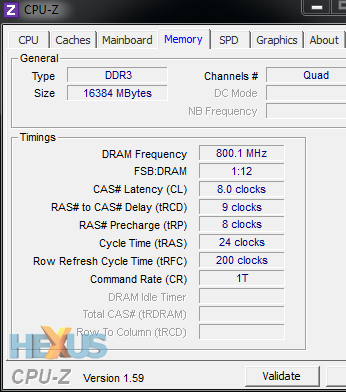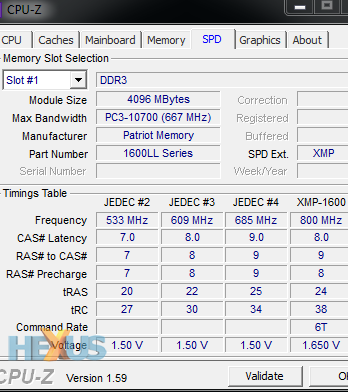How we test
 |
 |
Comparison Memory |
|||
|---|---|---|---|
| Patriot Viper Extreme 16GB | G.Skill RipjawsZ 16GB | G.Skill RipjawsZ 8GB | |
| Model | PXQ316G00LLQK | F3-12800CL9Q-16GBZL | F3-12800CL9Q-16GBZL (halved) |
| Capacity | 16GB (4x4GB) | 16GB (4x4GB) | 8GB (2x4GB) |
| Speed | 1,600MHz DDR3 | 1,600MHz DDR3 | 1,600MHz DDR3 |
| Timings | 8-9-8-24-1T | 9-9-9-24-2T | 9-9-9-24-2T |
| Voltage | 1.65V | 1.50V | 1.50V |
| Price* | £100 | £75 | £40 |
| Cost per GB* | £6.66 | £4.79 | £5 |
| *Approximate, correct at time of writing | |||
Test bench |
|||||||||
|---|---|---|---|---|---|---|---|---|---|
| CPU | Intel Core-i7 3930K (3.2GHz, 12MB L3 cache, hexa-core, LGA2011) | ||||||||
| Motherboard | ASUS Sabertooth X79 TUF (0802 BIOS) | ||||||||
| Storage device | Crucial 256GB RealSSD C300 (SATA 6Gbps) | ||||||||
| Graphics card | Sapphire Radeon HD 6950 2GB (Catalyst 11.11) | ||||||||
| Power supply | Corsair HX1000 | ||||||||
| Operating system | Windows 7 Ultimate SP1, 64-bit | ||||||||
Benchmarks |
|---|
| SiSoft Sandra 2012 Lite (download) |
| HEXUS.PiFast (download) |
| Cinebench R11.5 (download) |
| 3DMark 11 v1.0.1.0 (download) |
| Formula 1 2010 (homepage) |
| Just Cause 2 (homepage) |
| Battlefield 3 (homepage) |
Notes
We've already taken a look at 'regular' DDR3-1,600 memory, as it pertains to a Sandy Bridge-E platform. That perusal of the G.Skill set also showed the lack of difference if dropping from quad-channel to dual-channel. In that respect, pushing down the latencies shouldn't have too big an impact on overall performance.Overclocking
We're providing a very rough estimate of the overclocking ability the Patriot kit by seeing how well it scales when raising the memory multiplier on the ASUS board. Maximum voltage is set to the default 1.65V.
1,600MHz (9-9-9-24-2T) |
1,866MHz (9-9-9-24-2T) |
2,133MHz (9-9-9-24-2T) |
|
|---|---|---|---|
| Patriot Division 4 Viper Xtreme 16GB | |||
It has no problem in running looser timings at higher speeds, but 2,133MHz was out of reach. Fiddling around with the bus clock and checking smaller incremental rises in frequency we learned that, at 9-9-9-24-2T, the sample set topped out at just shy of 2,000MHz.
We also tested with the preset 8-9-8-24-1T timings, as configured by the XMP setting. The board would occasionally boot into Windows at 1,866MHz but fail any stress test. Again, after zeroing-in on the actual stable frequency by means of adjusting the BCLK, we reckon that, at the presets, an overclocked speed of about 1,800MHz is achievable.
Our testing shows that the modules have a fairly small sweetspot; they've been engineered with low-ish latencies and a moderate speed in mind.









